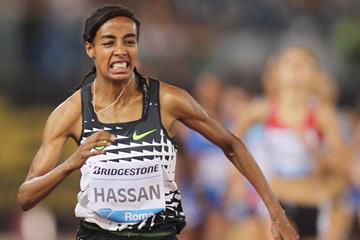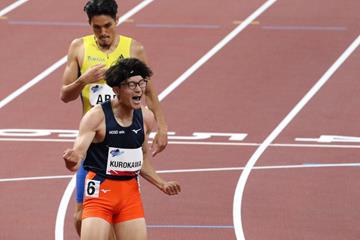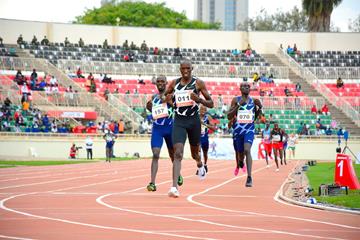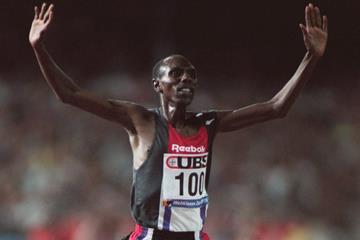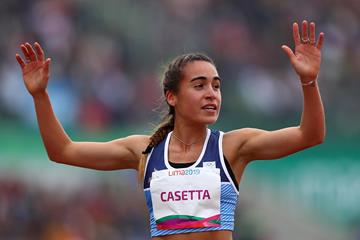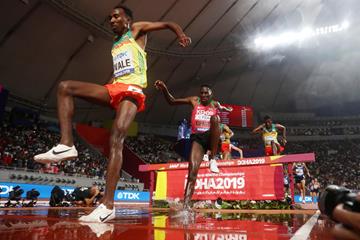 Countdown
Countdown
 Countdown
Countdown
The 3000m steeplechase is a middle-distance running event where athletes compete to cross the finish line first. Throughout the 3000m race, there are 28 fixed barriers and seven water jumps, which must be carefully but quickly traversed. Athletes make a bunched standing start and can break immediately for the inside.
The barriers are similar to hurdles. However, because they’re fixed in place, athletes can step on them, using them to push off.
As the name suggests, the water jumps have a small pool on the far side, which runners must jump into.
The 3000m steeplechase requires a great deal of strength, endurance, an impressive aerobic capacity and high levels of agility.
Although athletes cover a distance of 3000m, the precise location of the start line depends on the position of the water jump and whether it is placed on the inside or the outside of the track’s second bend.
The 3000m steeplechase is a track event where athletes run 3000m while clearing fixed barriers and water jumps. It’s the only distance event on the programme where athletes have to negotiate barriers.
The name of the event comes from its origins in Great Britain, where runners would race from one town’s steeple to the next
The modern steeplechase can be traced to Oxford University in the mid-19th century. The event was then added to the English Championships in 1879
The current format has been contested by men – initially over varying distances – at every Olympic Games since 1900. Meanwhile, the women’s event made its Olympic debut in 2008
A standard 3000m steeplechase track features 28 fixed barriers and seven water jumps
The height of the barriers in the men’s 3000m steeplechase is 36in (91.4cm) and in the women’s it’s 30in (76.2cm)
The length of the water jump’s landing area is 12ft (3.66m) and has a depth of 50cm
Kenyan runners have won every Olympic gold in the men’s 3000m steeplechase except three since 1968
In the women’s steeplechase, athletes from Russia, Tunisia, Bahrain and Uganda won the 2008, 2012, 2016 and 2020 Olympic titles respectively

The 3000m steeplechase is categorised as a middle-distance event, but with 28 barriers and seven water jumps, it’s incredibly taxing on the mind and body.
The first pre-recognition women’s 3000m steeplechase world record was set by Sara Heeb in April 1996, when she ran 10:34.5.
The first recognised women’s 3000m steeplechase world record was set by Russian athlete Yelena Motalova, with a time of 9:48.88.
The current world record is held by Kenyan runner Beatrice Chepkoech. She ran 8:44.32 in July 2018.
The first men’s 3000m steeplechase world record of 9.49.8 was set by Swedish athlete Josef Ternstrom in July 1914.
The first time the men’s 3000m steeplechase was run in under nine minutes was in August 1944, when Swede Erik Elmsater ran 8.59.6. It was another 51 years until the first athlete ran the 3000m steeplechase in less than eight minutes. In 1995, Kenyan athlete Moses Kiptanui achieved a time of 7:59.18.
The current men’s 3000m steeplechase world record-holder is Ethiopian runner Lamecha Girma, with 7:52.11 set in June 2023.
Since the 1960s, with a few notable exceptions, the nation leading the way for producing successful 3000m steeplechase athletes is without doubt Kenya.
Since 1968, Kenyan athletes have won Olympic gold in all but three men’s 3000m steeplechase events. In the 1992 and 2004 Olympic Games, Kenya took all three medals for the event.
Notable men’s 3000m steeplechase runners include Kenya’s Moses Kiptanui, Conseslus Kipruto, Brimin Kipruto and Ezekiel Kemboi. Moroccan Soufiane El Bakkali is the Olympic champion and the 2022 and 2023 world gold medallist.
Kenya has also produced many successful women’s 3000m steeplechase athletes, including Milcah Chemos Cheywa and Beatrice Chepkoech. However, no Kenyan athletes have won the women’s Olympic gold in the event. Notable Olympic champions include Peruth Chemutai (Uganda) and Habiba Ghribi (Tunisia).
The 3000m steeplechase is the longest race that features obstacles, so athletes need a lot of skill, technique, agility and endurance.
Athletes must focus on balancing speed, hurdling technique and long jump technique. This helps them clear water jumps and ensures they spend as little time in the water as possible
Athletes either hurdle or step over barriers, with different techniques suiting different athletes
Athletes will complete various anaerobic exercises that help them build speed and endurance before a race
Improving core strength is imperative for traversing barriers and water jumps
There are different phases to the 3000m steeplechase:
Athletes take their positions on the starting line and wait for the call, ‘On your marks.’ Athletes mustn’t touch the ground and can only begin the race on the sound of the starting pistol.
Athletes settle into a comfortable pace. They must avoid going too fast and instead pace themselves. Athletes will typically merge into a group after the first bend.
Athletes maintain a steady pace to avoid burnout. Energy is generally conserved to help runners cross barriers and water jumps.
No matter whether an athlete is more comfortable hurdling or stepping on barriers, consistency is important. Athletes will want to minimise the amount of time in the water after a water jump by jumping the farthest distance.
Athletes will slowly increase their speed to gain an advantage over other competitors. The final lap will often be the fastest as athletes use all their remaining energy to push to cross the finish line in the fastest time.
After the final barrier, athletes sprint to the finish line, overcoming physical and mental strain in an effort to come first. The winner is the athlete whose torso crosses the line first.
The 3000m steeplechase has many rules that athletes and organisers must abide by, with many key rules helping to differentiate the event from other similar events.
There is a standard barrier height in both the men’s and women’s 3000m steeplechase:
Men: 36in (91.4 cm)
Women: 30in (76.2 cm)
The barriers are fixed, so cannot fall when knocked, unlike hurdles.
The water pit is 12 feet (3.66m) in length and slopes from the barrier to the track level. At its deepest point, closest to the barrier, the pit is approximately 50cm deep.
The event takes place on a standard 400m outdoor track and athletes run approximately 7.5 laps, though this can vary slightly depending on whether the water jump is placed on the inner or outer lane.
Starting blocks are not used for the 3000m steeplechase, so false starts are identified through visual observation.
As with other middle and long-distance running events, athletes are disqualified immediately after a false start in the 3000m steeplechase. Additionally, athletes may also be disqualified if they fail to clear a barrier or water jump, or bypass an obstacle completely.
The winner is the athlete whose torso crosses the finish line first. If any other body parts cross the finish line first (for example, head, hands or feet), this isn’t considered.
The race order is typically determined using seeding and qualifying times.
Unlike short-distance and horizontal jumping events, there are no weather considerations for the 3000m steeplechase..
A steeplechase is an event where athletes must navigate obstacles and water jumps throughout the track.
The most common steeplechase event in athletics is the 3000m steeplechase, which includes 35 obstacles: 28 fixed barriers and seven water jumps.
The winner is the athlete who finishes approximately 7.5 laps of the 4oom track in the shortest time.
The 3000m steeplechase consists of 28 fixed barriers and seven water jumps, for a total of 35 obstacles. The obstacles can be hurdled or stepped on and cannot be bypassed.
The barriers and water jumps in the 3000m steeplechase are fixed and don’t fall over. As a result, athletes can choose to jump over the barriers or step on them to get a longer jump.
Paris 2024 Olympic Games
World Athletics Championships Tokyo 25
World Athletics U20 Championships Lima 24
 MAR
MAR
 KEN
KEN
 GER
GER
 ETH
ETH
 MAR
MAR
 ETH
ETH
 JPN
JPN
 ESP
ESP
 KEN
KEN
 TUN
TUN
 KEN
KEN
 BRN
BRN
 ETH
ETH
 TUN
TUN
 KAZ
KAZ
 UGA
UGA
 KEN
KEN
 USA
USA
 GER
GER
 USA
USA
